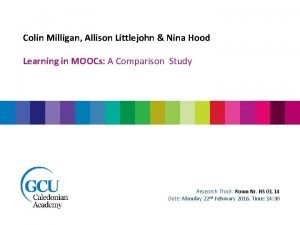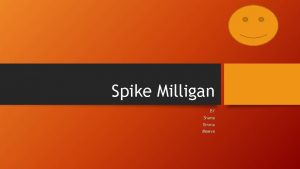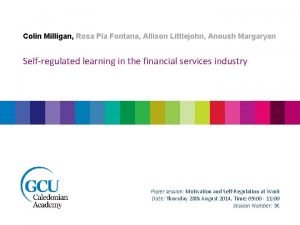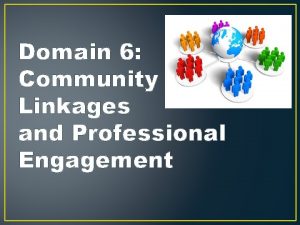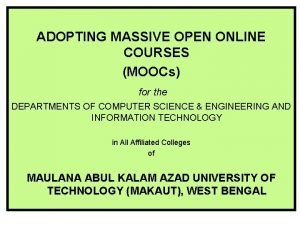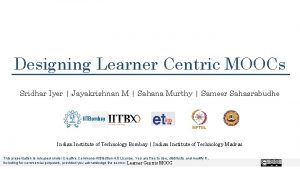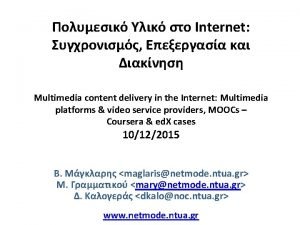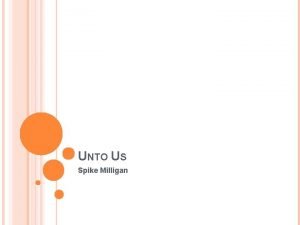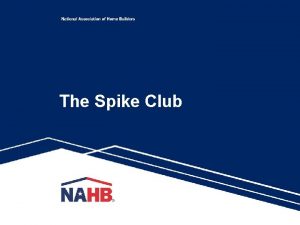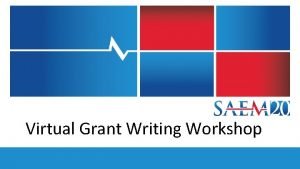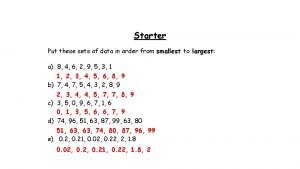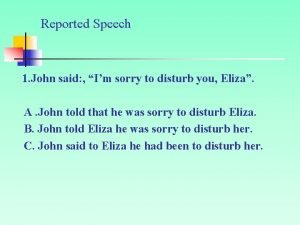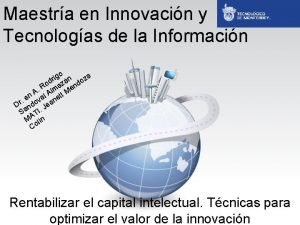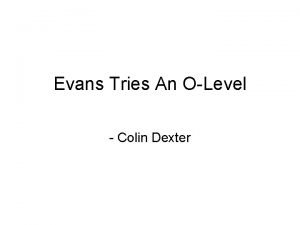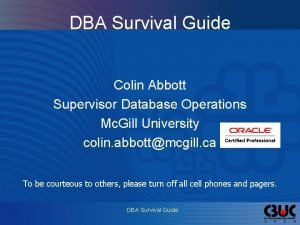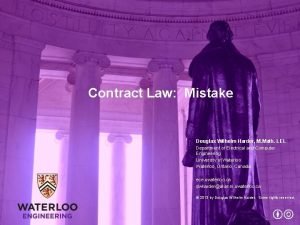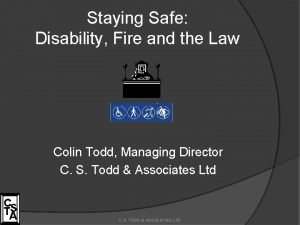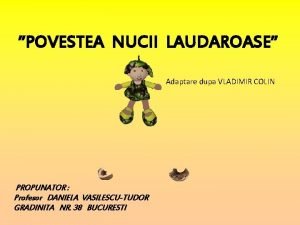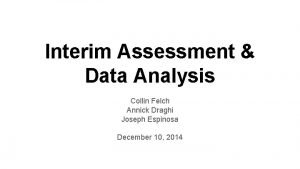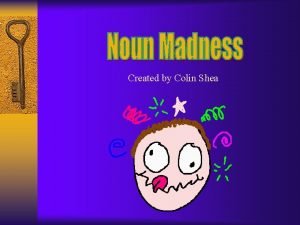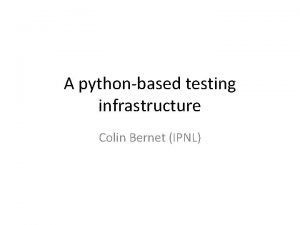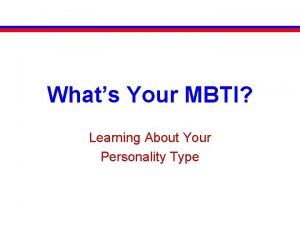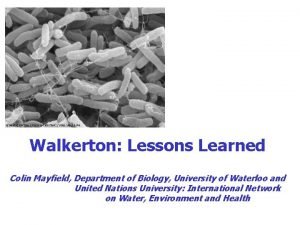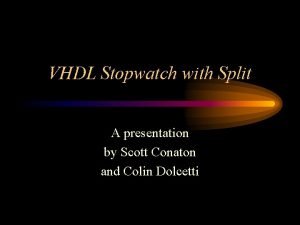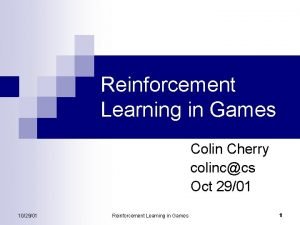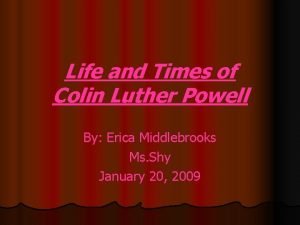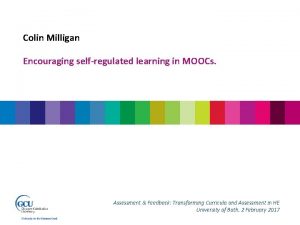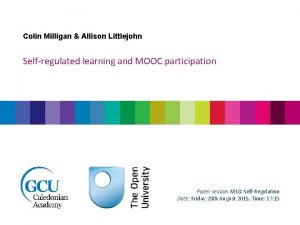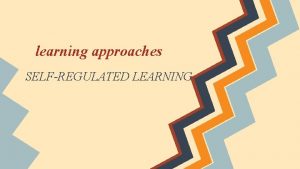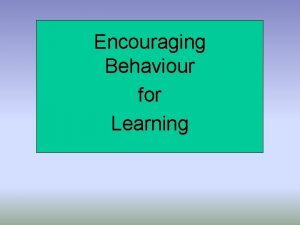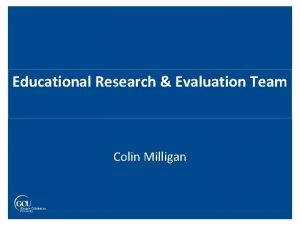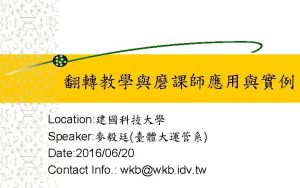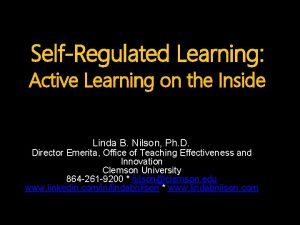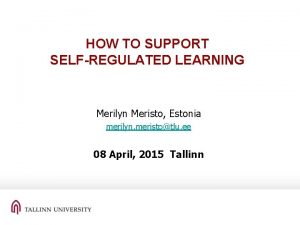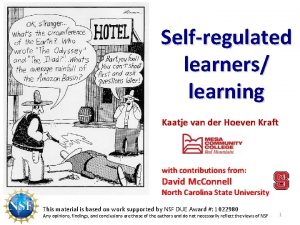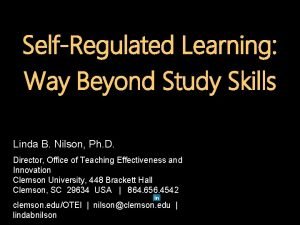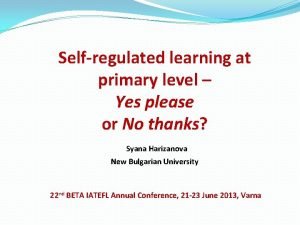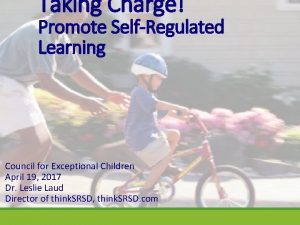Colin Milligan Encouraging selfregulated learning in MOOCs Assessment








































- Slides: 40

Colin Milligan Encouraging self-regulated learning in MOOCs. Assessment & Feedback: Transforming Curricula and Assessment in HE University of Bath, 2 February 2017

Outline • • MOOCs and Self-Regulated Learning, What we did, What we found: Individual studies, emerging themes, Reflection on implications: for MOOCs, and learning in general. • How this presentation fits the rest of the day.

Background Massive Open Online Courses • Massively popular, • Content-centric, pedagogically simplistic. FORETHOUGHT • Our interest: how are they being used by professionals – are they living up to their promise. SELFREFLECTION PERFORMANCE

Self-Regulated Learning Self-regulation is the ‘self-generated thoughts, feelings and actions that are planned and cyclically adapted to the attainment of personal goals’ - Zimmerman, 2000. FORETHOUGHT SELFREFLECTION PERFORMANCE

Phases and Sub-Processes of SRL Self-Regulated Learning (adapted from Zimmerman, 2000) Phase Forethought Sub-processes Goal setting Self-efficacy Task interest/value Performance Learning and Task strategies Help seeking Interest enhancement Self-reflection Self-evaluation Self-satisfaction/affect FORETHOUGHT SRL is highly context dependent – an individual may be unable to (or may choose not to) self-regulate SELFin some contexts. REFLECTION PERFORMANCE

Self-regulated learners • • • Plan and take responsibility for their learning, Intrinsically motivated, Self-confident, Seek help, Match learning strategies to situation, Monitor and reflect on their learning. All important attributes for MOOC study?

Research Questions & Study Design • RQ 1 How are MOOCs currently designed to support self-regulated learning? • RQ 2 What self-regulated learning strategies do professionals apply in a MOOC? • RQ 3 How can MOOCs be designed to encourage professionals to self-regulate their learning? Littlejohn, A, & Milligan, C. (2015). Designing MOOCs for professional learners: tools and patterns to encourage self-regulated learning. e. Learning Papers, 42, 38 -45. Milligan, C. & Littlejohn, A. (2014). Supporting professional learning in a massive open online course. International Review of Research in Open and Distance Learning 15(5) 197 -213. Milligan, C. & Littlejohn. A. (2016). How health professionals regulate their learning in MOOCs. The Internet & Higher Education 31, 113121. Littlejohn, A. , Hood, N. , Milligan, C. & Mustain, P. (2016). Learning in MOOCs, motivations and self-regulated learning. The Internet and Higher Education. 29, 40 -48.

Contexts & Cohorts • Fundamentals of Clinical Trials (ed. X, 2013 -4). • Participants were professionals across a range of roles – medicine, healthcare, statistics, bioscientists, pharmacists. • 35 interviewees [16 m, 19 f], 23 countries. • Drawn from 350 survey respondents. • Introduction to Data Science (Coursera, 2014). • Participants were data professionals across a range of roles – software engineers, data analysts, scientists. • 32 interviewees [27 m, 5 f], 16 countries. • Drawn from 768 survey respondents.

Video, with commentary. . .


Method & Analysis • Administer quantitative instrument: • to gain a measure of the extent to which they are self-regulating in this context, • • • Recruit volunteers for interviews, Undertake interviews, Code interviews, Sort by SRL score and sub-process score (high/low), Look for patterns of SRL: • and how it differs between the two groups.

Instrument: SRL Questionnaire • A measure of SRL for each respondent. Items were tailored to encourage participants to reflect specifically on their learning practices in the MOOC, • Adapted from SRL in non-formal contexts instrument, previously validated (Fontana et al, 2015), • This in turn was constructed from existing instruments: • MSLQ (Pintrich et al, 1991); MAI (Schraw & Dennison, 1994); OSLQ (Barnard-Brak et al, 2010); LS (Warr & Downing, 2000); OS (Rigotti, Schyns & Mohr, 2008). • Instrument available from figshare: http: //figshare. com/articles/SRLMQ/866774


SR is at lfs ct fa io n n io en t ua t al ev g in ek c. et ce m ha n Se lf- es se p- el H En Se 1 2 SR st re te In P 2 FCT 152 P 3 ue -3, 00 Va l -2, 50 -3, 00 ra te gi -2, 50 st -2, 00 sk -2, 00 g -1, 50 re st -1, 50 Ta -1, 00 tin -0, 50 -1, 00 et -0, 50 te 0, 00 In 0, 00 l. S 0, 50 sk cy 0, 50 oa ca io n 1, 00 G f-e ffi Se l ct fa 1, 50 1, 00 F 2 F 1 is io n en t lu at va at lfs Se lfe Se 1, 50 Ta 2 1 g in ek c. et ce m ha n En se p- el 2, 00 F 3 SR SR st re te In ue Va l es ra te gi H st g tin cy ca et l. S re st te In P 2 sk Ta oa G f-e ffi Se l 2, 00 P 1 P 3 P 1 F 3 F 2 F 1 SRL Profiles FCT 213

Instrument: Semi-Structured Interview • Explored various aspects of MOOC learning, structured around SRL sub-processes including self-efficacy, goalsetting and learning and task strategies, as well as patterns of help-seeking, self-reflection etc. • Available from figshare (IDS version): https: //figshare. com/articles/Interview_Script_SRL_in_MOOCs_IDS_/1300050


Findings Expectations of Professionals Category Relevance to current role Learning content Interest in the topic Future Career Other motive Total FCT Professional n (%), rank 46 (38. 3%) 1 29 (24. 2%) 2 117 (14. 2%) 3 13 (10. 8%) 5 15 (12. 5%) 4 120 IDS Professional n (%), rank 117 (44. 3%) 56 (21. 2%) 2 149 (18. 6%) 3 36 (13. 6%) 4 6 (2. 3%) 5 264 Combined Professional n (%) 163 (42. 4%) 85 (22. 1%) 66 (17. 2%) 49 (12. 8%) 21 (5. 5%) 384 Milligan & Littlejohn, in press (2017)

SRL Profiles PL-MOOC 152 2, 00 1, 50 1, 00 0, 50 0, 00 -0, 50 -1, 00 -1, 50 -2, 00 -2, 50 -3, 00 F 1 Self-efficacy. F 2 Goal Setting F 3 Task P 1 Task Interest Value strategies etc. P 2 Helpseeking P 3 Interest Enhancement SR 1 Selfevaluation SR 2 Selfsatisfaction

Self-efficacy: I’m sure after this course I’ll be much better in dealing with my daily job tasks. Help-seeking: So if something is not clear for me or something I need to understand I check the ongoing discussion related to this issue. Strategic learning (learning and task strategies): When I’m studying in the MOOC I get very concentrated on the video content and the homework content and the assignments and whatever resource is needed to provide these assignments. I don’t distract myself much more because of the time constraints. (FCT 152) Milligan & Littlejohn, 2016

SRL Profiles PL-MOOC 213 2, 00 1, 50 1, 00 0, 50 0, 00 -0, 50 -1, 00 -1, 50 -2, 00 -2, 50 -3, 00 F 1 Selfefficacy F 2 Goal Setting F 3 Task P 1 Task Interest Value strategies etc. P 2 Helpseeking P 3 Interest SR 1 Self. Enhancement evaluation SR 2 Selfsatisfaction

Low Self efficacy: I hoped I can get the certificate, but I found it quite difficult for me. I tried to get through the course. Well because of my work I don’t have very much time and so I may not achieve my original goal. Learning and task strategy: (when asked whether she takes notes) Not in this course. Sometimes I will consult my text book that I have. (FCT: 213) Milligan & Littlejohn, 2016

Goal-setting HIGH • Detailed, learning/mastery goals set, emotionally invested, and focused on role or career, • Goals reference professional roles and future needs, improving skillset, gaining content knowledge, • Only a minority focused on completion. LOW • Goals more abstract, focused on love of learning, • Or extrinsically motivated, focused on completion/certification.

• Greater specificity of goals among high SRL group: The main aim is to become a better data analyst and get my introduction and get the concept I need for data science, especially data science that involves around building Map. Reduce programmes and Python programmes. (IDS 673) • Intrinsic over extrinsic motivation among high SRL group. I would like to have finished the class, to get the certificate, but it wasn't really for that. I think it’s more personal, like a personal goal, like I just wanted to learn from the best. So it’s great that you have a certificate, but I’m not about the piece of paper, I’m about the learning opportunity. (FCT 334)

Self-efficacy HIGH • Clear and detailed descriptions demonstrating individual responsibility. • Confidence in ability arising from specific factors: • previously familiar with content knowledge, • previous participation in a MOOC. LOW • Less detailed descriptions, • Almost half indicated low self-efficacy, • Some participants lacked ability or confidence to evaluate own learning.

• Good self-efficacy across the board: I’m very familiar with the course, I already have a good background, I have all the resources and knowledge about this issue. (FCT 152) • Lack of confidence in a subset who had not studied online before or who lacked background knowledge: I found myself lost, this is due to the background, maybe that I was deficient” … “I always start searching on an internet engine, but it needs some sort of assistance. (FCT 316)

Learning and Task Strategies HIGH • note taking standard, • most did not change approach (did not feel the need to), • minority made active decision to change (time pressures). • wide variety of strategies used, flexible and adaptive in approach, LOW • only a minority took notes, • almost half changed approach BUT remainder had faced challenges but not changed: citing time pressures as a barrier (as opposed to a driver for change). • linear approach adopted, highly structured, inflexible.

SR is at lfs ct fa io n n io en t ua t al ev g in ek c. et ce m ha n Se lf- es se p- el H En Se 1 2 SR st re te In P 2 FCT 334 P 3 -3, 00 e -3, 00 gi -2, 50 te -2, 50 ra -2, 00 Va lu -2, 00 st -1, 50 re -1, 00 sk -0, 50 -1, 00 Ta -0, 50 et tin g 0, 00 te 0, 00 In 0, 50 sk 0, 50 oa l. S ca cy io n 1, 00 G f-e ffi Se l ct fa lu at t en m 1, 50 1, 00 F 2 F 1 is at lfs Se va lfe Se 1, 50 Ta 2 1 g in c. ue et ek ce ha n En se p- el s eg ie Va l et tin g ca cy 2, 00 F 3 SR SR st re te In ra t H st re st te In P 2 sk Ta oa l. S G f-e ffi Se l 2, 00 P 1 P 3 P 1 F 3 F 2 F 1 SRL Profiles FCT 394

Help-seeking: I’ve never really been a study group person, I’ve always been a study group person leader, I’ve always kind of worked with them to help them. So it’s hard for me to…I haven’t made any friends in class! If you learn from other people who don’t know what they’re talking about you could teach yourself the wrong thing. … I read them but I take them with a grain of salt, I’m like ‘I don’t know if this person knows what they’re talking about’. I don’t interact probably as much as I could. (FCT 334)

Differences: Course Topic & Format FCT IDS • Interdisciplinary – focused • Aimed at programmers, on diverse aspects of who wanted to gain skill in clinical trials: ethics, an emerging domain. statistics, • Adopted a very rigid • Included projects – structure opportunities for in depth • Came from a prestigious University: Harvard • Came from a very good University: U. Washington

Differences: Learning and Task Strategies • Note taking a standard approach for FCT while not universal among IDS learners, • High SRL FCT learners kept to the rigid structure of the course, following it: They recommend readings /books where you can dig deeper into the subject … I could have gone more in depth, although I chose not to because I didn’t think I needed more in depth just now. (FCT 143) • High SRL IDS learner were more flexible in their approach: I think my knowledge and my background and my work experience was very, very helpful, because whenever I saw something I understood I just ditched it and went to another part of the course. (IDS 239)

Conclusions & Reflection • Professionals come with diverse expectations. • Individuals self-regulate their learning to varying degrees, • Some learners need more support/assistance than the standard MOOC model allows. • Course topic and format can shape expectations and learning approach adopted.

MOOCs and Professional Learners Can we articulate patterns or elements of course design that could work for professional learners? … these are untested.

Study Recommendations 1. Enable professional learners to link theory learned in the MOOC with their work practice by setting personal goals, or personalizing course goals. 2. Help professional learners to reflect on the knowledge gained from the course and how it may be embedded into their work practice before the end of the course. 3. Capitalize on the diversity of motivation, expectation, and prior knowledge and experience that is an inherent within all MOOC cohorts. 4. Encourage professional learners to discuss ideas from the course with coworkers in their external professional network as well as with other learners on the course. https: //figshare. com/articles/MOOC_Design_Recommendations/1420557

Enable professional learners to link theory learned in the MOOC with their work practice • Learners could be encouraged to do this by articulating personal goals, or personalizing course goals. • Additional tasks could encourage learners to develop and share action plans for embedding new knowledge into their own practice. • Examples generated by learners could form a growing resource illustrating the many ways in which theory and practice might be linked.

Help professional learners to reflect on the knowledge gained from the course and how it may be embedded into their work practice before the end of the course. • Certificates may have limited value for some professionals. • Instead course designs can be tailored to support learners in creating an output of lasting value as demonstration of their learning. • Set authentic tasks which have a clear useful output that learners can include in their portfolio as a record of achievement. For example. • learners could be asked to specify an output based on a current challenge, and work to complete it through the course. • learners with similar backgrounds could work together to critique policy or conduct a foresighting exercise. • learners with complementary expertise could be brought together to define and resolve real-world problems.

Capitalize on the diversity of motivation, expectation, and prior knowledge and experience that is an inherent within all MOOC cohorts. • Recognise the knowledge and experience that your learners bring. • Turn the problem of diversity into a benefit, by using the diverse experience of MOOC learners to enrich course: • Create opportunities for sharing existing knowledge. • Build heterogeneous networks (e. g. professionals from different disciplines or same disciplines in different contexts). • Recognise the need for homogeneous networks too: • Build communities with similar goals, or unifying features (locale, language) where appropriate.

Encourage professional learners to discuss ideas from the course with co-workers in their external professional network as well as with other learners • Professional learners bring ready-made professional networks. • Instead of attempting to create new, high quality communities inside courses from scratch for every cohort, designers can encourage learners to use their pre-existing networks to discuss course ideas and the questions they have. • Discussion with one’s own colleagues is high value as it is localised and directly relevant to practice. • An individual’s existing network is a trusted resource and can be activated easily through face to face or social media platforms such as Facebook, Yammer or Twitter. • Use external networks to drive internal discussion.

Thank you Dr Colin Milligan Educational Research & Evaluation Department of Academic Development & Quality GLASGOW CALEDONIAN UNIVERSITY Glasgow, SCOTLAND colin. milligan@gcu. ac. uk @cdmilligan Slides (with notes) available from: https: //figshare. com/articles/_Presentation_Encouraging_selfregulated_learning_in_MOOCs/4602316 This work was originally funded by the Bill & Melinda Gates Foundation and carried out with Professor Allison Littlejohn. Thanks to Obiageli Ukadike, Nabeel Gillani and Bill Howe for access and assistance, and Lou Mc. Gill for conducting interviews.

References Milligan, C. & Littlejohn, A. (2014). Supporting professional learning in a massive open online course. International Review of Research in Open and Distance Learning 15(5) 197 -213. Littlejohn, A, & Milligan, C. (2015). Designing MOOCs for professional learners: tools and patterns to encourage selfregulated learning. e. Learning Papers, 42, 38 -45. Littlejohn, A. , Hood, N. , Milligan, C. & Mustain, P. (2016). Learning in MOOCs, motivations and self-regulated learning. The Internet and Higher Education. 29, 40 -48. Hood, N. , Littlejohn, A. , and Milligan, C. , (2015) Context counts: How Learners' Contexts influence learning in a MOOC. Computers and Education 91, 83 -91 Milligan, C. & Littlejohn. A. (2016). How health professionals regulate their learning in MOOCs. The Internet & Higher Education 31, 113 -121. Milligan, C. & Littlejohn, A. (2017, to appear). Why study on a MOOC? The motives of students and professionals. International Review of Research in Open and Distributed Learning

References Bandura, A. (1986). Social foundations of thought and action: A social cognitive theory. Englewood Cliffs, NJ: Prentice Hall. Bernacki, M. L. , Aguilar, A. & Byrnes, J. (2011). Self-regulated learning and technology-enhanced learning environments: An opportunity propensity analysis. In G. Dettori and D. Persico (Eds. ), Fostering self-regulated learning through ICT (pp. 1 -26). Hershey, PA: IGI Global Publishers. Breslow, L. , Pritchard, D. E. , De. Boer, J. , Stump, G. S. , Ho, A. D. & Seaton, D. T. (2013). Studying learning in the worldwide classroom: Research into ed. X’s first MOOC. Journal of Research & Practice in Assessment, 8, 13– 25. Fontana, R. P. , Milligan, C. , Littlejohn, A. & Margaryan, A. (2015). Measuring self-regulated learning in the workplace. International Journal of Training and Development. 19(1) 32 -52. Gašević, D. , Kovanović, V. , Joksimović, S. & Siemens, G. (2014). Where is Research on Massive Open Online Courses Headed? A Data Analysis of the MOOC Research Initiative. International Review of Research in Open and Distance Learning, 15(5), 134 -176. Gillani, N. & Eynon, R. (2014). Communication patterns in massively open online courses. The Internet and Higher Education, 23, 18 -26. Haug, S. , Wodzicki, K. , Cress, U. & Moskaliuk, J. (2014). Self-Regulated Learning in MOOCs: Do Open Badges and Certificates of Attendance Motivate Learners to Invest More? In U. Cress & C. D. Kloos (Eds. ). EMOOCs 2014 - European MOOC Stakeholder Summit, (pp. 66 -72). Lausanne, Switzerland. Kizilcec, R. F. , Piech, C. & Schneider, E. (2013). Deconstructing disengagement: Analysing learner subpopulations in massive open online courses. In Proceedings of the 3 rd International Conference on Learning Analytics and Knowledge (pp. 170– 179). New York, NY, USA: ACM. Retrieved 8 April 2015, from: http: //dl. acm. org/citation. cfm? id=2460330 Margaryan, A. , Bianco, M. & Littlejohn, A. (2015). Instructional quality of Massive Open Online Courses (MOOCs). Computers & Education, 80, 77 -83. Milligan, C. , Littlejohn, A. & Margaryan, A. (2013). Patterns of engagement in connectivist MOOCs. MERLOT Journal of Online Learning & Teaching 9(2), 149 -159. Poellhuber, B. , Roy, N. Boucha, I. & Anderson, T. (2014). The relationships between the motivational profiles, engagement profiles and persistence of MOOC participants. MOOC Research Initiative, Final Report. Ryan, R. M. & Deci, E. L. (2000). Intrinsic and extrinsic motivations: classic definitions and new directions. Contemporary Educational Psychology, 25, 54 -67. Veletsianos, G. , Collier, A. & Schneider, E. (2015). Digging Deeper into Learners Experiences in MOOCs: Participation in social networks outside of MOOCs, Note-taking, and contexts surrounding content consumption. British Journal of Educational Technology, 46, 570 - 587 Wang, Y. & Baker, R. (2015). Content or platform: why do students complete MOOCs. MERLOT Journal of Online Learning and Teaching, 11(1), 17 -30. Zheng, S. , Rosson, M. B. , Shih, P. C. & Carroll, J. M. (2015). Understanding Student Motivation, Behaviors and Perceptions in MOOCs. In Proceedings of the 18 th ACM Conference on Computer Supported Cooperative Work & Social Computing (pp. 1882 -1895). ACM. Zimmerman, B. J. (2000). Attaining self-regulation: a social cognitive perspective. In M. Boekaerts, M. Zeidner, and P. R. Pintrich (Eds. ), Handbook of selfregulation (pp 13 -39). Academic Press, San Diego, CA.
 Nina hood
Nina hood Romany milligan
Romany milligan Pia fontana
Pia fontana Ppst domain 6 reflection
Ppst domain 6 reflection Moocs makaut
Moocs makaut Iit bombay x
Iit bombay x Designing learner-centric moocs
Designing learner-centric moocs Massive open online courses
Massive open online courses Unto us by spike milligan
Unto us by spike milligan Ex parte milligan apush
Ex parte milligan apush Unto us spike milligan
Unto us spike milligan Ruth milligan
Ruth milligan Cuadro comparativo de e-learning b-learning y m-learning
Cuadro comparativo de e-learning b-learning y m-learning Encouragement about giving tithes and offering
Encouragement about giving tithes and offering Dreikurs
Dreikurs Alice chen md
Alice chen md Scform unibo
Scform unibo Colin took a sample of 80 football players
Colin took a sample of 80 football players John said he
John said he Or is it just a hit and run
Or is it just a hit and run Jeanett mendoza colín
Jeanett mendoza colín Colin dexter evans
Colin dexter evans Colin abbott
Colin abbott Types of mistakes
Types of mistakes Colin henry wilson
Colin henry wilson Colin powell scholarship
Colin powell scholarship Colin powell situational leadership
Colin powell situational leadership Colin todd fire
Colin todd fire Povestea nucii laudaroase
Povestea nucii laudaroase Newtons laws od motion
Newtons laws od motion Colin felch
Colin felch Dr. colin tench
Dr. colin tench Mr colin shea
Mr colin shea Colin chipping campden
Colin chipping campden Colin bernet
Colin bernet Goldie hawn mbti
Goldie hawn mbti Colin mayfield
Colin mayfield Vhdl stopwatch
Vhdl stopwatch Colin cherry experiment
Colin cherry experiment Powell colin a leadership primer
Powell colin a leadership primer Maud arial
Maud arial
